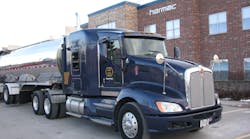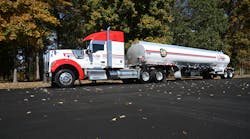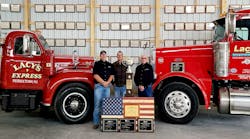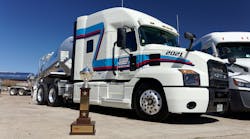JIM Shaeffer’s year as National Tank Truck Carriers chairman was one of the busiest anyone has faced in that position. Topping the list of significant projects was the transition to a new NTTC president.
Changes were made in the association’s governing structure; new programs were developed—including the new professional tank truck driver award; government advocacy efforts were expanded and the association’s political action committee was strengthened; and training programs—such as the Cargo Tank Workshops—were expanded.
“We made a lot of improvements over the past year that we believe will benefit current members and attract new members to the association,” says Shaeffer, who is also president and chief executive officer of McKenzie Tank Lines Inc in Tallahassee, Florida. “Our governing reorganization was critical in positioning this association for the future. “
NTTC has a strong reputation that was earned through more than 70 years of service to the tank truck industry, its vendor associates, and customers in a wide range of industries. This is a well-respected association that has built strong relationships with other associations and government agencies that deal with hazardous materials transportation and handling.”
Shaeffer presides over a family-owned tank truck carrier that operates primarily in the eastern half of the United States. Founded in the 1940s by Guy McKenzie Sr, McKenzie Tank Lines hauls a range of products including refined petroleum and chemicals.
The original focus was on petroleum, and McKenzie Sr started with a trucking company called State Oil, which consisted of two trucks that hauled fuel during World War II. The company name was changed to South State Oil at one point and was finally as McKenzie Tank Lines. McKenzie Sr also bought an LTL carrier called MR&R Trucking.
Shaeffer has been the top executive of the company for the past 18 years and has helped it grow into a $50 million-plus carrier that was ranked 26th on Bulk Transporter’s most recent Gross Revenue Report. So how did a non-family member get to the top of a family company?
Shaeffer offers a relatively simple answer: “My father and our founder Guy McKenzie Sr were childhood friends growing up in Bainbridge, Georgia. They remained good friends even though my dad, as a chemical engineer, moved to different places. We came back to the area, and they picked up their friendship again. My father never worked for Mr McKenzie. They just remained friends.”
“As a child, I used to play cowboys and Indians with Mr McKenzie’s youngest daughter, who is now our chairman of the board. I’ve been very close with the McKenzie family for a long time. I’ve enjoyed the career I’ve had with their company, and I appreciate their trust in allowing me the opportunity to serve in a leadership role as president and CEO for over 18 years.”
While he grew up around the McKenzies, Shaeffer wasn’t initially looking at a career in tank trucking. He was an advertising major in college and became very involved in photo journalism.
“I had a professor who used to work for Life magazine, and he found that I had a knack for photography,” he says. “In fact, I spent my last year in school working as a photographer. I was a 20-hour staff member at the University of Florida College of Engineering. When I graduated, I had two job offers as a photographer. My dad suggested I go talk to Mr McKenzie, who wanted to discuss some opportunities in the transportation industry.
“I accepted a manager/trainee job (in 1973) with the LTL fleet, which had operations in Florida, Georgia, and Alabama. The plan was to send me to Atlanta, and my thought was that after six months to a year, I would probably move on to advertising. I didn’t initially see my future in trucking.”
Mr McKenzie Sr wanted his young trainees to learn the business from the ground up, and Shaeffer spent the first weeks of his employment washing trucks. Next, he learned how to handle freight working on the dock at the Atlanta, Georgia, terminal.
In 1981, Shaeffer was tapped by the McKenzie family for a move to the tank fleet. “I had spent eight years in the LTL business before moving to the tank line,” he says. “I was told that I would have a pretty good chance to become involved in senior management of the tank fleet at some point in my career.”
NTTC Chairman page 2...
It meant starting fresh as an assistant terminal manager for McKenzie Tank Lines to learn the different nuances of the bulk business. “It’s a very technical business,” he says. “Just consider the variations in trailers: aluminum, stainless steel, high pressure, elevated temperature, and an almost infinite variety of components.
Shaeffer found out early on that he liked the challenges of tank truck operations. “This industry brings a lot of satisfaction to someone who likes to put a puzzle together every day,” he says. “I would liken the job of a dispatcher or terminal manager to someone who puts a puzzle together every day, and the pieces are always a little different. Some days there may be more pieces than others. Hopefully they all fit.”
The company sent Shaeffer to Houston, Texas, to open McKenzie Tank Lines first terminal west of the Mississippi River in 1982. He remained there until 1986.
“The tank truck business in Houston in 1982 was very exciting,” he says. “I pulled out the Yellow Pages and saw there were more than 50 tank truck carriers in Houston at the time. Today, there are over 100 in Houston. It’s the tank truck capital of North America and possibly the world.
“At Christmas time when I still lived in Houston, I used to drive over the Beltway 8 Bridge and look at the chemical plants and refineries lining the Ship Channel. To me, they looked like Christmas lights.
One thing coming out of his many years in the industry is a deeper understanding of the role tank truck fleets play in our nation’s economy. “We transport products that go into your drinking water, that make the tensile strength of the fabric in your shirt stronger, that make athletic shoes whiter,” Shaeffer says. “This industry touches virtually every industry in our economy.”
Almost immediately after moving to the tank truck side, Shaeffer began attending NTTC conferences. “I started going to meetings 19 years ago,” he says. “The first was at Whistler, British Columbia (Canada). I was encouraged to get involved by Guy McKenzie Jr, who had been NTTC chairman. He felt I would make some excellent business contacts. I attended the Executive Strategies Forums in Chicago (Illinois). I also attended the Leadership Training program at Purdue University the same year as Phil McKinley (McKinley Trucking Co Inc).”
With the regular meeting attendance came an invitation to become involved in the association’s leadership. “I remember that at one point, Scott Miller (Miller Transporters Inc) asked me about my background,” Shaeffer says. “Shortly after that, Bob Schurer (Transport Service Co) asked if I would like to be on the executive committee as audit committee chairman. That was probably 14 years ago. I had a great deal of respect for my peers in the industry and felt it was a great honor.”
Participation in NTTC’s leadership process has given Shaeffer a front row seat to observe firsthand the regulatory process in Washington DC that has a direct impact on tank truck carriers of all sizes and types.
He has seen the importance of building an association that is robust and flexible enough to effectively represent the industry as the federal government continues to spew out new regulations and even resurrect failed efforts.
Shaeffer sat down recently on the Battleship Alabama in Mobile, Alabama, to discuss the current state of the tank truck industry and how the changes at NTTC will affect members and potential members.
BT: How would you describe the state of the tank truck industry?
Shaeffer: The state of the industry is strong with the current economic trends, but I believe one reason we’re in such good shape is the energy sector, particularly the oil and gas shale plays. The chemical sector seems to be growing at a very steady, modest rate.
BT: What do you see ahead for the rest of this year?
Shaeffer: At our company, we’re planning for growth. It should be slow, but steady.
BT: What is the situation on capacity in the tank truck industry?
Shaeffer: There is too much capacity in the tank truck business, and it’s a fragmented industry. We still have a lot of family owned carriers and a lot of 50-truck fleets. New startups can still enter the business.
BT: Can owner-operators survive in today’s trucking market?
Shaeffer: I think the larger question is: Can they survive the political climate that seeks to make it difficult if not impossible to classify them as independent contractors rather than employees. They are entrepreneurs. They are building businesses.
BT: What impact are you seeing from Obamacare?
Shaeffer: It is a huge issue that I believe very few people understand. Health costs certainly are rising.
We’ve had different presentations at several NTTC meetings. This program seems to be still evolving. From what I have seen, companies could save a lot of money by dropping health insurance and just paying the fines.
However, in a business where you are competing for good employees, that is a benefit that is very important. We have a grandfathered plan that meets all of the requirements. The biggest problem is that you are very restricted with these plans when the costs increase. Our health care costs have increased significantly over the past two years. It’s an excellent plan that we expect to continue offering to our employees, but it is expensive.
NTTC Chairman page 3...
BT: What are the key issues for the tank truck industry at this time?
Shaeffer: The driver shortage tops the list.
BT: What is the central concern about drivers?
Shaeffer: It’s a serious problem. One thing that concerns me most is the aging of the driver force. Within our company, the average age is 50. We also have some 70-year-old drivers.
It’s a challenge for the industry. I’ve done some research and found in the transportation business that the only segment with a mandatory retirement age is for commercial airline pilots.
BT: Should there be a mandatory truck driver retirement age?
Shaeffer: I believe there should. Our company has many loyal, longtime employees—30 years plus. I would hate for any of them to have a significant health failure while still driving a truck past the point where they should. Once drivers reach a certain age, we require them to have a physical at least annually, which is more frequently than the DOT requires.
BT: Have your screenings resulted in taking drivers off the road?
Shaeffer: Yes, and, in some instances, we have done some function-specific testing to determine whether an older driver is still physically able to handle his responsibilities. That’s very important in a business where they are climbing and are required to have good balance.
BT: What will it take to bring more and younger drivers into the industry?
Shaeffer: A combination of compensation for the drivers and working conditions. By working conditions, I mean more home time and more local work.
BT: With the driver shortage growing, what do you see as new sources of drivers?
Shaeffer: The military may be one of the best sources. We had a panel discussion at the 2013 Summer Board meeting looking at ways to make the tank truck industry a career destination for military veterans. We can offer stable employment opportunities and good benefits. We’re not just looking for drivers. We also need dispatchers, maintenance technicians, and management staff. Some of our best technicians are military veterans.
At McKenzie Tank Lines, we have a number of great military veterans driving for us in Florida and Georgia. They are safety conscious and disciplined. They embrace our training program.
BT: what are other critical issues for the tank truck industry?
Shaeffer: CSA (the Federal Motor Carrier Safety Administration’s Compliance, Safety, Accountability program). Anytime you start to measure something that is relevant to safety, it can be beneficial. However, to continue using the accident metric without regard to preventability can be a problem.
The wetlines issue appears to be coming back, and we are going to have to defeat it again. NTTC has just engaged an outside lobbyist to help in this latest effort to defeat this regulatory initiative. NTTC provided scientific information in the past to help defeat a previous regulatory push.
Beyond the federal regulations, indemnification at the state level is still a concern. We’ve done a fairly good job of promoting legislation in many states to eliminate abusive indemnification clauses in contracts. Many shippers and brokers are now trying to step around those prohibitions by shifting liabilities. For example, they are asking carriers to name the shipper or broker to have primary coverage under the liability coverage and waiving them of financial responsibility in various ways. It’s about leverage.
BT: In light of the proposed federal mandate, how do you feel about electronic driver logs?
Shaeffer: I absolutely love electronic logging systems. The technology simplifies the driver’s and dispatcher’s jobs. More importantly, it ensures that we are using the best tools available to be in compliance with hours-of-service rules. Dispatchers don’t have to contact drivers individually to determine who has the hours to haul a load. Electronic logs can give us the data we need to justify a rate adjustment.
BT: In addition to electronic driver logs, what other safety technology has McKenzie Tank Lines explored over the years?
Shaeffer: We were invited by Mack Trucks to participate in a project with FMCSA back in the 1990s. It was called the Intelligent Vehicle Initiative. The objective was to determine if technology that wasn’t even commercially available could be successfully used to reduce the frequency and severity of commercial vehicle accidents.
We had 36 vehicles in that study. With the test results we saw, we knew that all of this technology was great, so we embraced it very early on—lane departure warning system, collision warning systems. We spec’d vehicle stability systems on our fleet as soon as they were available in North America. We have all of these systems on our trucks today.
The most important thing that I’ve seen in my career is the critical event warning system that ties all of the other technologies together. We get real time satellite notifications of events, such as hard braking, stability system activation, and such.
NTTC Chairman page 4...
BT: How would you characterize your year as NTTC chairman?
Shaeffer: I think it has been good in the sense that we had a good staff transition when John Conley retired.
Several years ago there was a lack of continuity from one chairman to the next. We each have our hot issues but in recent years we have made a more effective transition. The immediate past chairman, current chairman and incoming chair work closely together with the NTTC President. This affords the incoming chairman opportunities to become more knowledgable about the business of the association. The result is a smooth transition between chairmen and continuity within the NTTC.
BT: What were the key association developments during your year as NTTC chairman?
Shaeffer: We concluded our succession planning for the executive suite with a smooth transition. The association has had just four presidents—Austin Sutherland, Cliff Harvison, John Conley, and now Dan Furth. This is an association that has been around for about 70 years. We felt it was important that the transition to the next president be a success. John Conley was kind enough to let us know well in advance of his intended retirement date. Having John on staff gave us ample opportunity for Dan to gain experience and learn from John.
We worked with the new team to chart a strategic course. We beefed up the staff. We’re following the strategic plan.
BT: Was NTTC understaffed as an association?
Shaeffer: I would say they were understaffed if they were going to try to enhance the value the association provides to the members.
BT: Going forward, what are the objectives of NTTC?
Shaeffer: We want growth in membership. We want to be able to share best practices between companies. We want more members from more areas of the country. We’ve already strengthened our representation in California. It’s a rewarding experience to sit down and talk candidly about common issues with a peer in the industry that is not a competitor.
BT: Where do we stand with the NTTC’s new Driver of the Year program?
Shaeffer: That also was a big development for the past year. We launched this program, which is huge. It was overdue. None of us who are executives in this business do anything that we can bill to a customer. Our drivers are the people who power this industry and get the job done. They haul the loads; they make the deliveries; they enable us to transport product and bill the customers, so we can make payroll, pay for fuel, buy equipment, and take care of the rest of our expenses.
Considering the role and responsibility that driver has that we recognize the professionalism and the accomplishments of these individuals. A McKenzie driver is one of the eight finalists, and I’m talking about that at our terminal safety banquets. It’s a big deal.
It’s so important to talk about the successes of drivers. I’ll give you an example. We have a large chemical customer, and they have an annual gathering at which they recognize safety initiatives at plants from all over the world. As their primary carrier in North America, we were asked to provide a driver and tractor-trailer so we could talk about safety technology. This was an opportunity for senior management at that chemical company to speak with our driver and see the truck with all of the technology. They were able to hear firsthand about the challenges we have in safely making every one of those deliveries.
BT: What has NTTC done in recent years to make membership more attractive?
Shaeffer: We restructured our varied membership types into three categories. Since we announced the new private fleet category in 2012, we’ve added 20 new members.
We’ve made investment in key areas to extend the brand, including content improvement at the events.
We planned a $100,000 investment in our new liquid products database initiative that focuses on preventing cargo tank corrosion. If NTTC doesn’t do this, it’s unlikely any other group will do it. It’s important, because there are many products we are asked to transport that may not have to be placarded as corrosive, yet these products still pit our stainless steel trailers.
In government affairs, we have expanded our advocacy efforts to broaden coverage of both legislative and regulatory relationships with increased focus on the NTTC Political Action Committee.
We expanded our Cargo Tank Workshop partnership with the Department of Transportation, and we have doubled the average class size from just four years ago.
We made a number of event improvements, including increased investment, better location selection, and enhanced programs. A great example was our highly successful Tank Truck Week in Houston, the largest event in NTTC history with attendance in excess of 1,300. We had more vendor booths and vehicle spots than ever before. ♦










